This pub is the former home of the Macclesfield Useful Knowledge Society (UKS), established in the early 19th century. The UKS moved into the 18th-century building on Park Green, originally built as St Michael’s vicarage. The original aim of the UKS was to teach the three Rs. The UKS’s art class became the School of Design, while its science classes led to the founding of the Technical School. Both the former vicarage (home of the UKS) and the Technical School alongside, built in 1900, form the site of this Wetherspoon pub.
Prints and text about The Society Rooms.
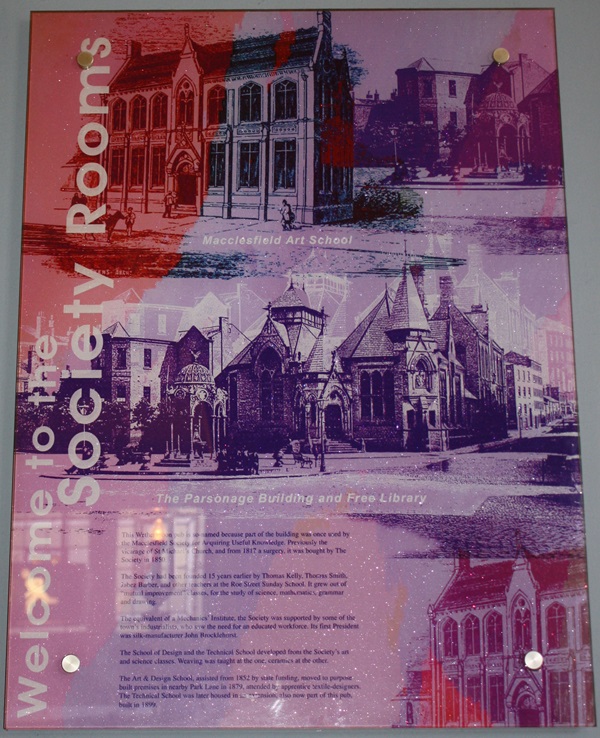
The text reads: This Wetherspoon pub is so-named because part of the building was once used by the Macclesfield Society for Acquiring Useful Knowledge. Previously the vicarage of St Michael’s Church, and from 1817 a surgery, it was bought by The Society in 1850.
The Society had been founded 15 years earlier by Thomas Kelly, Thomas Smith, Jabez barber, and other teachers at the Roe Street Sunday School. It grew out of “mutual improvement” classes, for the study of science, mathematics, grammar and drawing.
The equivalent of a Mechanics’ Institute, the Society was supported by some of the town’s industrialists, who saw the need for an educated workforce. Its first President was silk-manufactured John Brocklehurst.
The School of Design and the Technical School developed from the Society’s art and science classes. Weaving was taught at the one, ceramics at the other.
The Art & Design School, assisted from 1852 by state funding, moved to purpose built premises in nearby Park Lane in 1879, attended by apprentice textile-designers. The Technical School was later housed in an extension, also now part of this pub, built in 1899.
Prints and text about transport in Macclesfield.
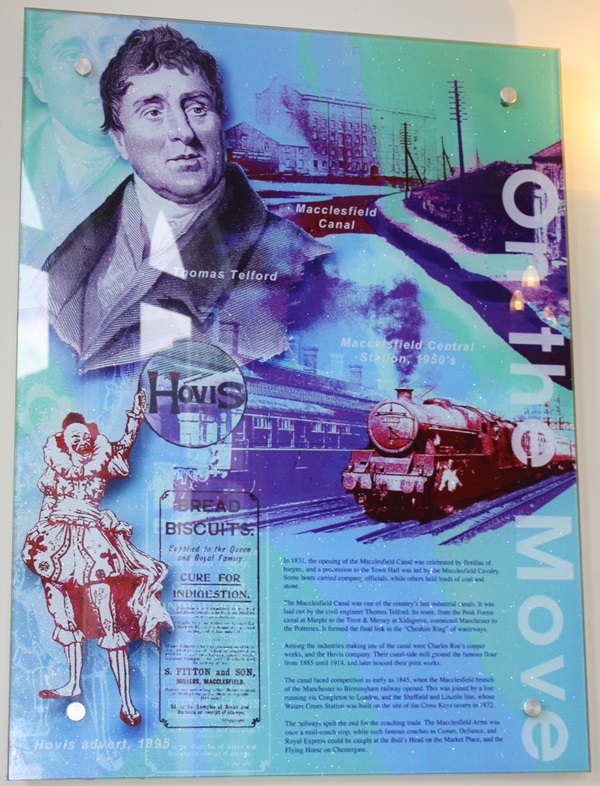
The text reads: In 1831, the opening of the Macclesfield Canal was celebrated by flotillas of barges, and a procession to the Town Hall was led by the Macclesfield Cavalry. Some boats carried company official, while others held loads of coal and stone.
The Macclesfield Canal was one of the country’s last industrial canals. It was laid out by the civil engineer Thomas Telford. Its route, from the Peak Forest canal at Marple to the Trent & Mersey at Kidsgrove, connected Manchester to the Potteries. It formed the final link in the “Cheshire Ring” of waterways.
Among the industries making use of the canal were Charles Roe’s copper works, and the Hovis company. Their canal-side mill ground the famous flour from 1885 until 1914, and later housed their print works.
The canal faced competition as early as 1845, when the Macclesfield branch of the Manchester to Birmingham railway opened. This was joined by a line running via Congleton to London, and the Sheffield and Lincoln line, who’s Waters Green Station, was built on the site of the Cross Keys tavern in 1872.
The railways spelt the end for the coaching trade. The Macclesfield Arms was once a mail-coach stop, while such famous coaches as Comet, Defiance and Royal Express could be caught at the Bull’s Head on the Market Place, and the Flying Horse on Chestergate.
Prints and text about the silk industry.
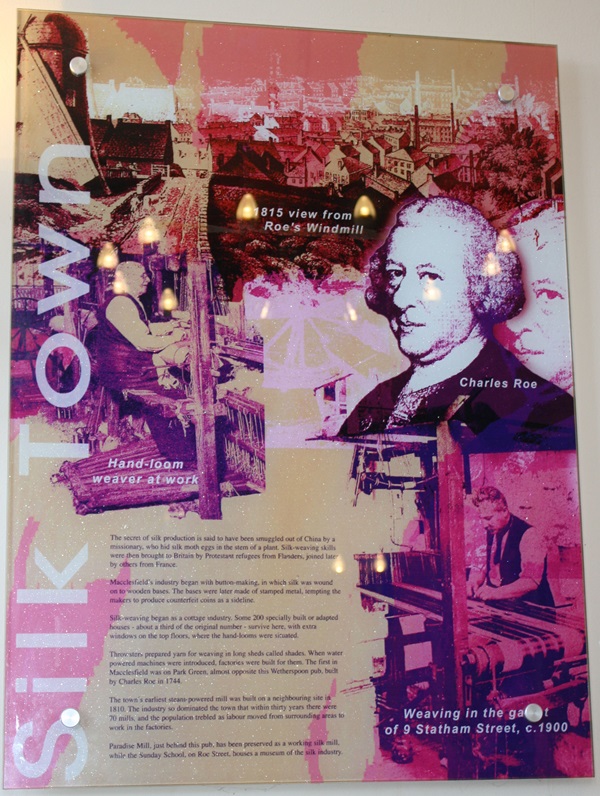
The text reads: The secret of silk production is said to have been smuggled out of China by a missionary, who hid silk moth eggs in the stem of a plant. Silk-weaving skills were then brought to Britain by Protestant refugees from Flanders, joined later by others from France.
Macclesfield’s industry began with button-making, in which silk was wound on to wooden bases. The bases were later made of stamped metal, tempting the makers to produce counterfeit coins as a sideline.
Silk-weaving began as a cottage industry. Some 200 specially built or adapted houses – about a third of the original number – survive here, with extra windows on the top floors, where the hand looms were situated.
Throwsters prepared yarn for weaving in long sheds called shades. When water powered machines were introduced, factories were built for them. The first in Macclesfield was on Park Green, almost opposite this Wetherspoon pub, built by Charles Roe in 1744.
The town’s earliest steam-powered mill was built on a neighbouring site in 1810. The industry so dominated the town that within thirty years there were 70 mills, and the production trebled as labour moved from surrounding areas to work in the factories.
Paradise Mill, just behind this pub, has been preserved as a working silk mill, while the Sunday School, on Roe Street, housed a museum of the silk industry.
Prints and text about Roe Street Sunday School.
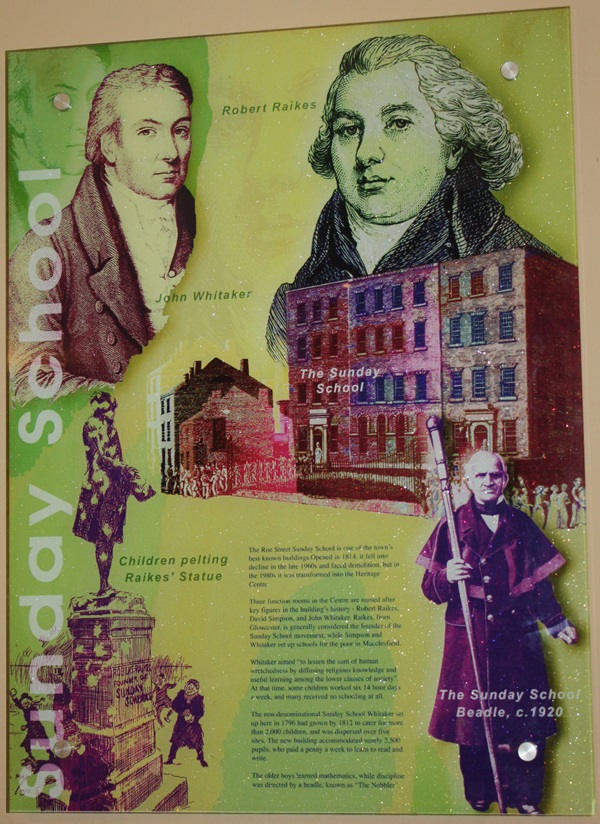
The text reads: The Roe Street Sunday School is one of the town’s best-known buildings. Opened in 1814, it fell into decline in the late 1960s and faced demolition, but in the 1980s it was transformed into the Heritage Centre.
Three function rooms in the Centre are named after key figures in the building’s history – Robert Raikes, David Simpson and John Whitaker. Raikes, from Gloucester, is generally considered the founder of the Sunday School movement, while Simpson and Whitaker set up schools for the poor in Macclesfield.
Whitaker aimed “to lessen the sum of human wretchedness by diffusing religious knowledge and useful learning among the lower classes of society”. At that time, some children worked six 14 hour days a week, and many received no schooling at all.
The non-denominational Sunday School Whitaker set up here in 1796 had grown by 1812 to cater for more than 2,000 children, and was dispersed over five sites. The new building accommodated nearly 2,500 pupils, who paid a penny a week to learn to read and write.
The older boys learned mathematics, while discipline was directed by a beadle, known as “The Nobbler”.
Prints and text about Prince Charles Edward Stuart.
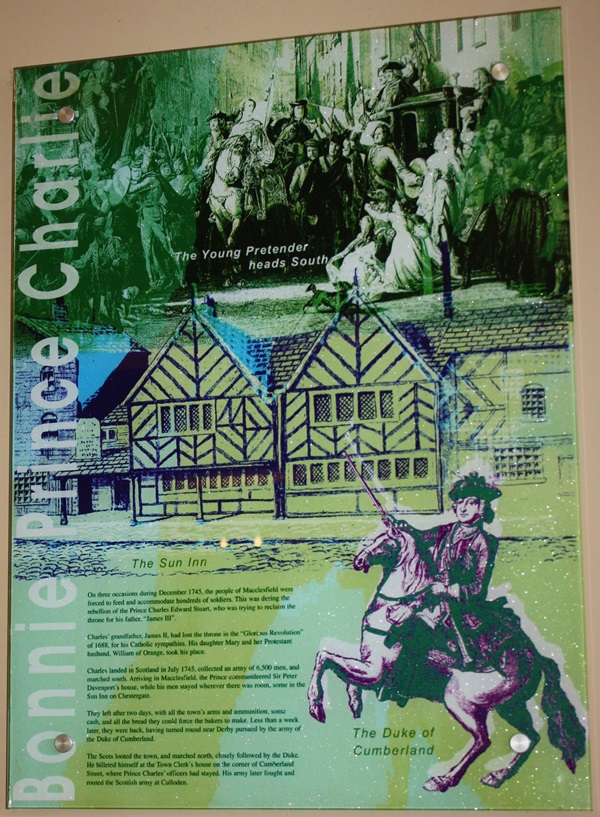
The text reads: On three occasions during December 1745, the people of Macclesfield were forced to feed and accommodate hundreds of soldiers. This was during hr rebellion of the Prince Charles Edward Stuart, who was trying to reclaim the throne for his father, “James III”.
Charles’ grandfather, James II, had lost the throne in the “Glorious Revolution” of 1688, for his Catholic sympathies. His daughter Mary and her Protestant husband, William of Orange, took his place.
Charles landed in Scotland in July 1745, collected and army of 6,500 men, and marched south. Arriving in Macclesfield, the Prince commandeered Sir Peter Davenport’s house, while his men stayed wherever there was room, some in the Sun Inn on Chestergate.
They left after two days, with all the town’s arms and ammunition, some cash, and all the bread they could force the bakers to make. Less than a week later, they were back, having turned round near Derby pursued by the army of the Duke of Cumberland.
The Scots looted the town, and marched north, closely followed by the Duke. Hi billeted himself at the Town Clerk’s house on the corner of Cumberland Street, where Prince Charles officers had stayed. His army later fought and routed the Scottish army at Culloden.
Photographs and text about Sir James Chadwick
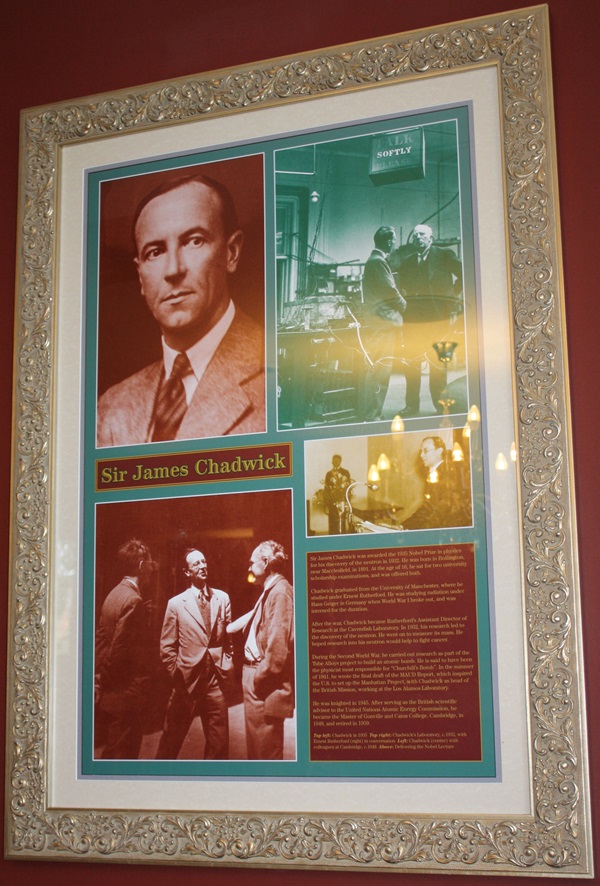
The text reads: Sir James Chadwick was awarded the 1935 Nobel Prize in physics for his discovery of the neutron in 1932. He was born in Bollington, near Macclesfield, in 1891. At the age of 16, he sat for two university scholarship examinations, and was offered both.
Chadwick graduated from the University of Manchester, where he studied under Ernest Rutherford. He was studying radiation under Hans Geiger in Germany when World War I broke out, and was interned for the duration.
After the war, Chadwick became Rutherford’s Assistant Director of Research at the Cavendish Laboratory. In 1932, his research led to the discovery of the neutron. He went on to measure its mass. He hoped research into his neutron would help to fight cancer.
During the Second World War, he carried out research as part of the Tube Alloys project to build an atomic bomb. He is said to have been the physicist most responsible for “Churchill’s Bomb”. In the summer of 1941, he wrote the final draft of the MAUD Report, which inspired the U.S. to set up the Manhattan Project, with Chadwick as head of the British Mission, working at the Los Alamos Laboratory.
He was knighted in 1945. After serving as the British scientific advisor to the United Nations Atomic Energy Commission, he became the Master of Gonville and Caius College, Cambridge, in 1948, and retired in 1959.
Top left: Chadwick in 1935
Top right: Chadwick’s Laboratory c1932, with Ernest Rutherford (right) in conversation
Left: Chadwick (centre) with colleagues at Cambridge c1948
Above: Delivering the Noble Lecture.
Photographs and text about Vera Brittain.
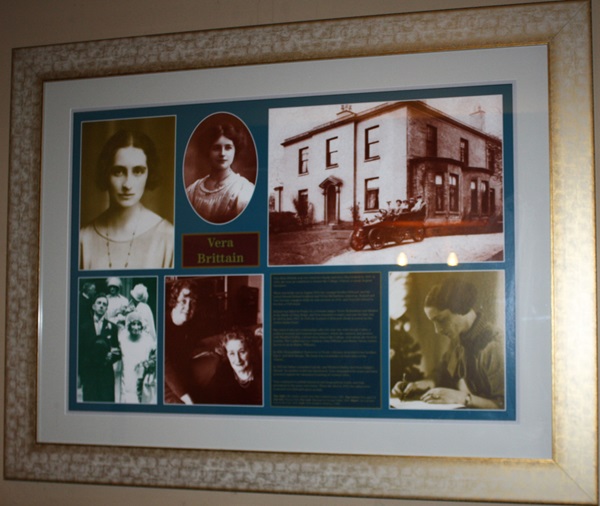
The text reads: Vera Mary Brittain was two when her family moved to Macclesfield in 1895. In 1914, she won an exhibition to Somerville College, Oxford, to study English Literature.
When war broke out in August 1914, her younger brother Edward, and his school friends Roland Leighton and Victor Richardson, joined up. Roland and Vera became engaged whilst he was on leave in 1915, and Vera left Oxford to become a VAD nurse.
Roland was killed in France by a German sniper. Victor Richardson was blinded at the Battle of Vimy Bridge, and Vera intended to marry and care for him, but he died in June 1917. In 1918 she learned of Edward’s death in action on the Austro-Italian front.
She entered into two relationships after the war, one with George Catlin, a political scientist and feminist sympathizer, whom she married, and another with Winifred Holtby, a friend from Somerville College, with whom she lived in London. The Catlin’s had two children: John Edward, and Shirley Vivien (better known to us as Shirley Williams).
The 1933, Vera published Testament of Youth, a literary memorial to her brother, fiancé and their friends. The book was a bestseller on both sides of the Atlantic.
In 1935 her father committed suicide, and Winifred Holtby died from Bright’s disease. As another world war threatened, Vera campaigned for peace and late protested against the saturation bombing of German cities.
Vera continued to publish historical and biographical works, and was prominent in the peace movement. When she died in 1970, her ashes were scattered over Edward’s grave in Italy.
Top right: The family outside their Macclesfield home, 1905
Top centre: Vera aged 16
Top left: Vera in 1924
Far left: Marriage to George Catlin, 1925
Right: On a lecture tour in the USA, 1934
Left: With daughter Shirley, c1965.
Photographs and text about Sir Philip Lee Brocklehurst.
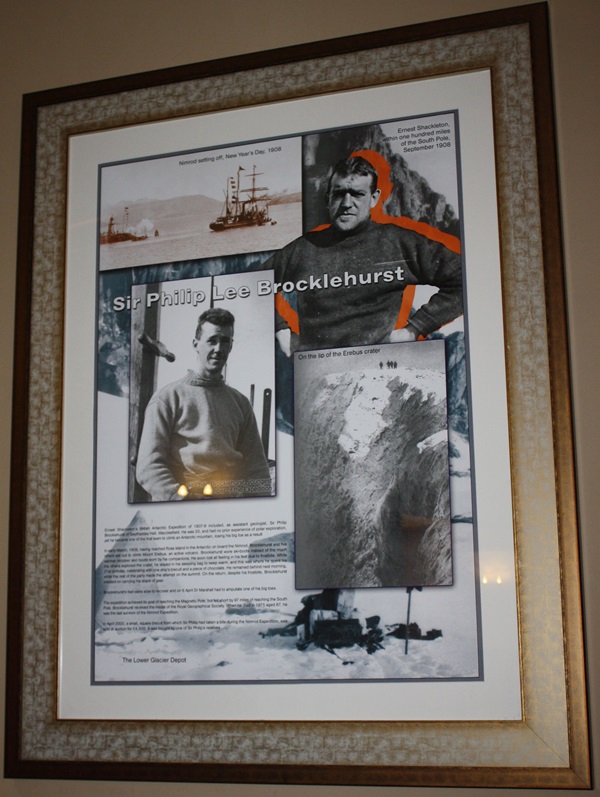
The text reads: Ernest Shackleton’s British Antarctic Expedition of 1907-9 included, as assistant geologist, Sir Philip Brocklehurst of Swythamley Hall, Macclesfield. He was 20, and had no prior experience of polar exploration, yet became one of the first team to climb an Antarctic mountain, losing his big toe as a result.
In early March, 1908, having reached Ross Island in the Antarctic on board the Nimrod, Brocklehurst and five others set out to climb Mount Erebus, an active volcano. Brocklehurst wore ski-boots instead of the much warmer reindeer skin boots worn by his companions. He soon lost all feeling in his feet due to frostbite. While the others explored the crater, he stayed in his sleeping bag to keep warm, and this was where he spent his 21st birthday, celebrating with one ship’s biscuit and a piece of chocolate. He remained behind next morning, while the rest of the party made the attempt on the summit. On the return, despite his frostbite, Brocklehurst insisted on carrying his share of gear.
Brocklehurst’s feet were slow to recover and on 6 April Dr Marshall had to amputate one of his big toes.
The expedition achieved its goal of reaching the Magnetic Pole, but fell short by 97 miles of reaching the South Pole. Brocklehurst received the medal of the Royal Geographical Society. When he died in 1975 aged 87, he was the last survivor of the Nimrod Expedition.
In April 2000, a small, square biscuit from which Sir Philip had taken a bite during the Nimrod Expedition was sold at auction for £4.935. It was bought by one of Sir Philip’s relatives.
Illustrations, photographs and text about Hovis.
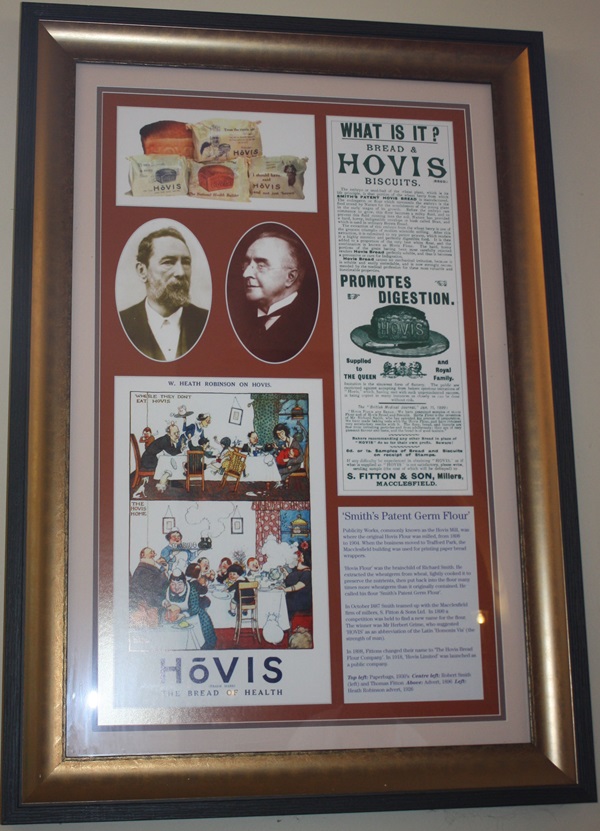
The text reads: Publicity Works, commonly known as the Hovis Mill, was where the original Hovis Flour was milled, from 1898 to 1904. When the business moved to Trafford Park, the Macclesfield building was used for printing paper bread wrappers.
‘Hovis Flour’ was the brainchild of Richard Smith. He extracted the wheatgerm from wheat, lightly cooked it to preserve the nutrients, then put back into the flour many times more wheatgerm than it originally contained. He called his flour ‘Smith’s Patent Germ Flour’.
In October 1887 Smith teamed up with the Macclesfield firm of miller, S Fitton & Sons Ltd. In 1890 a competition was held to find a new name for the flour. The winner was Mr Herbert Grime, who suggested ‘HOVIS’ as an abbreviation of the Latin ‘Homonis Vis’ (the strength of man).
In 1898, Fittons changed their named to ‘The Hovis Bread Flour Company’. In 1918, ‘Hovis Limited’ was launched as a public company.
Top left: Paperbags, 1930’s
Centre left: Robert Smith (left) and Thomas Fitton
Above: Advert, 1896
Left: Heath Robinson advert, 1926.
Photographs and text about Brian Redhead.
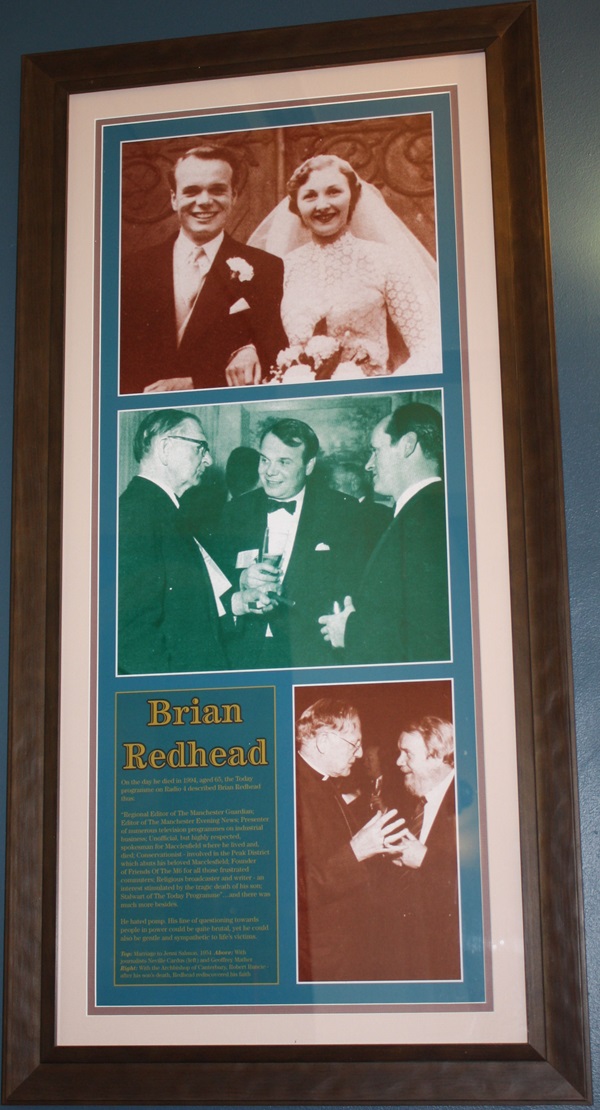
The text reads: On the day he died in 1994, aged 65, the today programme on Radio 4 described Brian Redhead thus:
“Regional Editor of The Manchester Guardian; Editor of The Manchester Evening News; Presenter of numerous television programmes on industrial businesses; Unofficial, but highly respected, spokesman for Macclesfield where he lived and, died; Conservationist – involved in the peak District which abuts his beloved Macclesfield; Founder of Friends Of The M6 for all those frustrated commuters; Religious broadcaster and writer – an interest stimulated by the tragic death of his son; Stalwart of The Today Programme”… and there was much more besides.
The hated pomp. His line of questioning towards people in power could be quite brutal, yet he could also be gentle and sympathetic to life’s victims.
Top: Marriage to Jenni Salmon, 1954
Above: With journalists Neville Cardus (left) and Geoffrey Mather
Right: With the Archbishop of Canterbury, Robert Runcie – after his son’s death, Redhead rediscovered his faith.
Photographs and text about Nick Robinson.
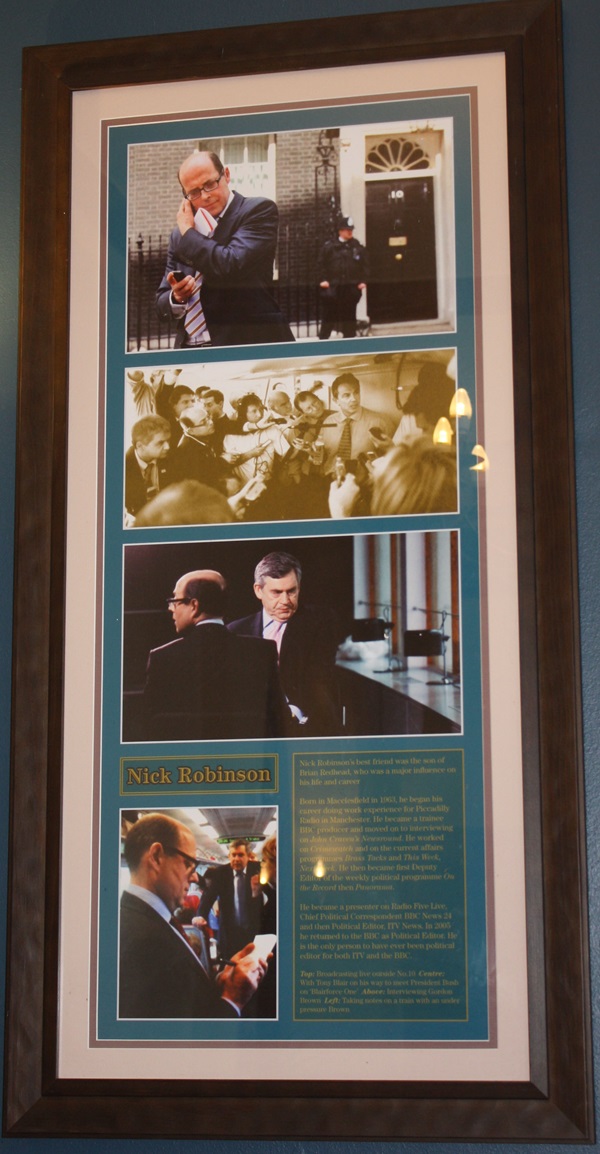
The text reads: Nick Robinson’s best friend was the son of Brian Redhead, who was a major influence on his life and career.
Born in Macclesfield in 1963, he began his career doing work experience for Piccadilly Radio in Manchester. He became a trainee BBC producer and moved on to interviewing on John Craven’s Newsround. He worked on Crimewatch and on the current affairs programmed Brass Tracks and This Week, Next Week. He then became first Deputy Editor of the weekly political programme On the Record and Panorama.
He became a presenter on Radio Five Live, Chief Political Correspondent BBC News 24 and then Political Editor, ITV News. In 2005 he returned to the BBC as Political Editor. He is the only person to have ever been political editor for both ITV and the BBC.
Top: Broadcasting live outside No.10
Centre: With Tony Blair on his was to meet President Bush on ‘Blairforce One’
Above: Interviewing Gordon Brown
Left: Taking notes on a train with an under pressure Brown.
Photographs and text about Terry Waite.
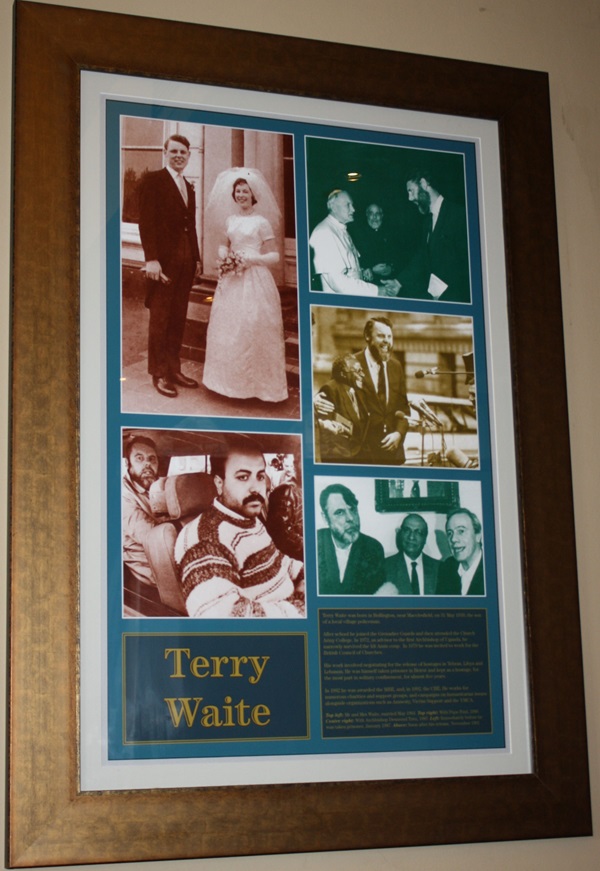
The text reads: Terry Waite was born in Bollington, near Macclesfield, on 31 May 1939, the son of a local village policeman.
After school he joined the grenadier Guards and then attended the Church Army College. In 1972, as advisor to the first Archbishop of Uganda, he narrowly survived the Idi Amin coup. In 1979 he was invited to work for the British Council of Churches.
His work involved negotiating for the release of hostages in Tehran, Libya and Lebanon. He was himself taken prisoner in Beirut and kept as a hostage, for the most part in solitary confinement, for almost five years.
In 1982 he was awarded the MBE, and, in 1992, the CBE. He works for numerous charities and support groups, and campaigns on humanitarian issues alongside organizations such as Amnesty, Victim Support and the YMCA.
Top left: Mr and Mrs Waite, married Mat 1964
Top right: With pope Paul, 1986
Centre right: With Archbishop Desmond Tutu, 1985
Left: Immediately before he was taken prisoner, January 1987
Above: Soon after his release, November 1991.
Photographs and text about John Mayall.
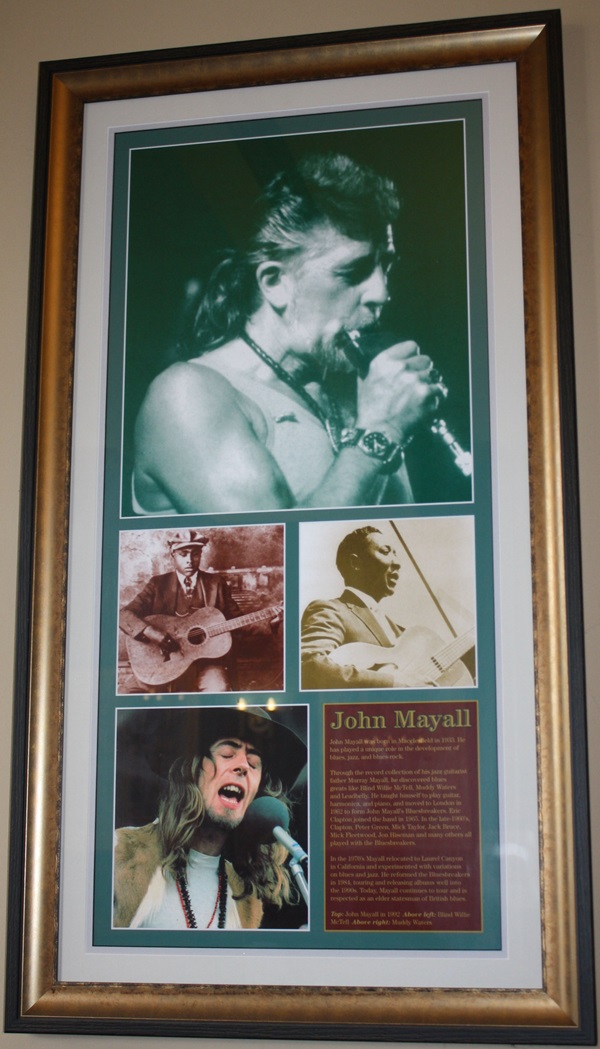
The text reads: John Mayall was born in Macclesfield in 1933. He has played a unique role in the development of blues, jazz and blues-rock.
Through the record collection of his jazz guitarist father Murray Mayall, he discovered blues greats like Blind Willie McTell, Muddy Waters and Leadbelly. He taught himself to play guitar, harmonica, and piano, and moved to London in 1962 to form John Mayall’s Bluesbreakers. Eric Clapton joined the band in 1965. In the late 1960’s, Clapton, Peter Green, Mick Taylor, Jack Bruce, Mick Fleetwood, John Hiseman and many others all played with the Bluesbreakers.
In the 1970’s Mayall relocated to Laurel Canyon in California and experimented with variations on blues and jazz. He reformed the Bluesbreakers in 1984, touring and releasing albums well into the 1990s. Today, Mayall continues to tour and is respected as an elder statesman of British blues.
Top: John Mayall in 1992
Above left: Blind Willie McTell
Above right: Muddy Waters.
A copy of a tapestry entitled The Tree of Life by William Morris.
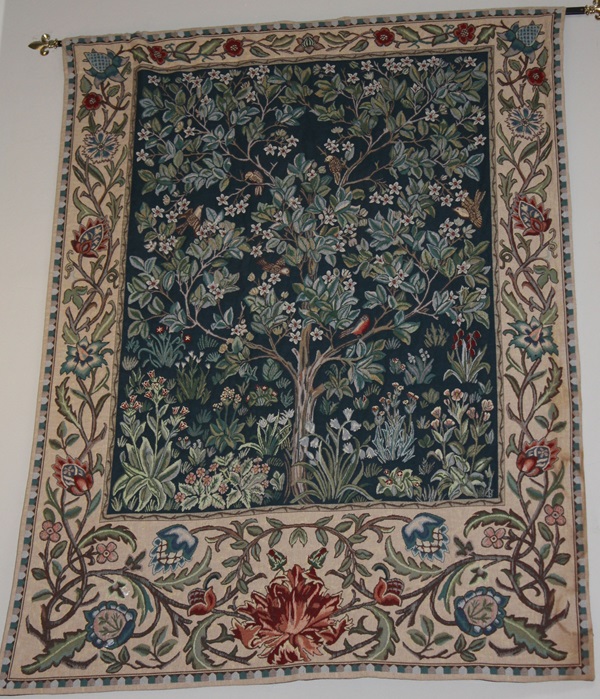
This tapestry is a facsimile of the original tapestry designed by William Morris & Co in around 1910.
Features of the design can be seen in many wallpaper and fabric patterns that Morris and Co also produced. The tapestry is symbolic of the growth and continuity of life.
William Morris founded the decorative arts form of Morris, Marshall, Faulkner & Co. in 1861, with artists Rossetti, Burne-Jones, Ford Madox Brown and Philip Webb as partners. The aim was to undertake traditional crafts such as stained glass, metal-work, printed fabrics and carpets. It was gradually extended to include painted windows and mural decoration, furniture, metal and glass wares, cloth and paper wall-hanging, embroideries, jewellery, woven and knotted carpets, silk damasks, and tapestries.
A copy of a tapestry entitled Wine Market.
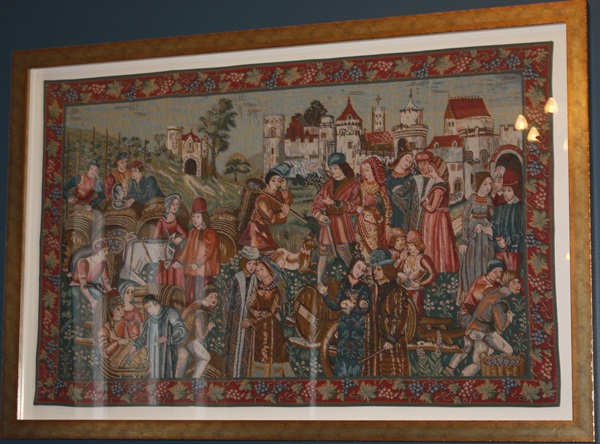
The text reads: This tapestry is a facsimile of the original woven in Flanders in the late 15th century. The tapestry depicts trading in the wine market, and is the companion piece to Grape Harvest, which is also displayed in this Wetherspoon free house.
During the Middle Ages tapestries were commissioned by the wealthy and tended to reflect dramatic themes and religious symbolism. More rarely work was commissioned to depict everyday scenes, like this piece, offering a rare glimpse into life during Medieval times. The original of this tapestry can be found in the Cluny Museum of Paris.
A copy of a tapestry entitled Grape Harvest.
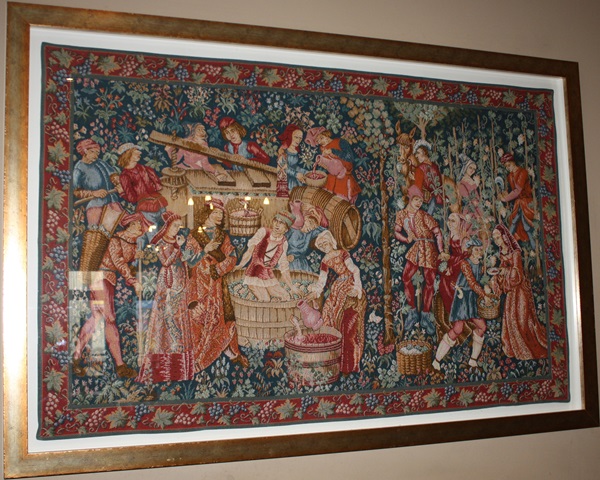
This tapestry is a facsimile of the original woven in Tournai in the late 15th century. Also known as Les Vendanges, it was designed to celebrate the annual wine harvest and we see the peasants gathering the grapes for use in wine making. Around the tapestry we also see the distinctive Mille Fleurs decoration typical of Medieval tapestries.
During the Middle Ages tapestries were commissioned by the wealthy and tended to reflect dramatic themes and religious symbolism. More rarely work was commissioned to depict everyday scenes, like this piece, offering a rare glimpse into life during Medieval times. The original of the tapestry can be found in the Cluny Museum in Paris.
External photograph of the building – main entrance.
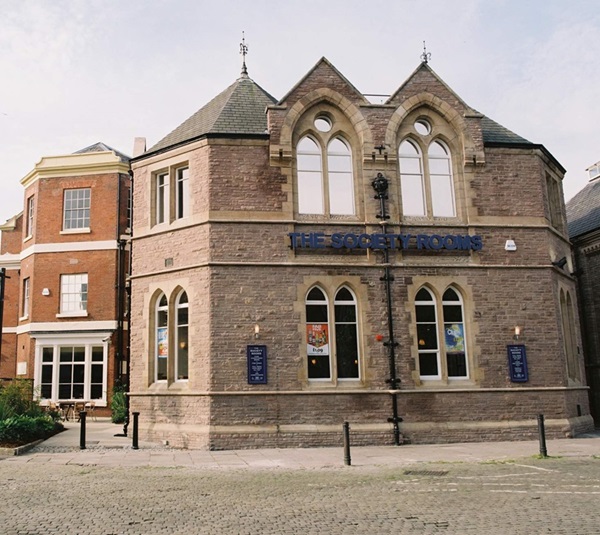
If you have information on the history of this pub, then we’d like you to share it with us. Please e-mail all information to: pubhistories@jdwetherspoon.co.uk